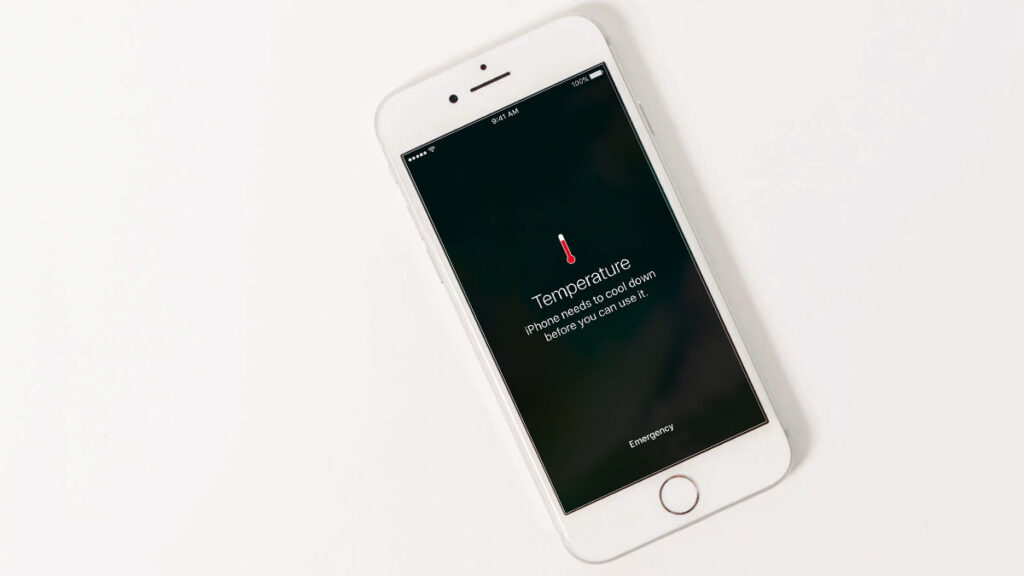How to cool down a hot iPhone

When smartphones get too hot they start to misbehave and may suffer long-term damage. There have even been a few cases where phones have exploded or burst into flame, although in these cases heat is generally the symptom (of a battery malfunction, for example) rather than the underlying cause of the issue.
It’s extremely unlikely that your iPhone is going to blow up, but troubleshooting its overheating problems now should give you some peace of mind and help it to run smoothly. In this article, we offer some simple tips to cool down a hot iPhone.
How to keep an iPhone cool
If your iPhone keeps overheating, you should look into where and how you are using it. These tips will help–of course, use these tips when possible:
Remove the case. An extra layer of insulation makes it harder for your phone to cool down. Alternatively, there are iPhone cooling cases available and thermal phone cases. Consider a case with heat vents. You can even attach a fan to your iPhone.
Don’t leave your phone in a car in the sun, where temperatures can rise rapidly. Take the iPhone with you. While in the car, you could put the iPhone in a car mount mounted in front of your vehicle’s air conditioning vents, such as this one from Miracase (U.K.) or this magnetic iPhone holder from Vicseed (U.S.).
Avoid direct sunlight entirely, especially if you’re somewhere extremely hot. If you’re on vacation somewhere fiercely sunny, keep the iPhone in a bag or the shade. Refrain from using the phone if possible.
Avoid playing games. Games, and particularly graphically advanced ones, tax the processor, which heats up the device. AR apps can be particularly taxing.
Stop using Bluetooth because it provides an additional source of heat. You can turn off Bluetooth from the Control Center: swipe down from the top right on an iPhone without a Home button and tap the Bluetooth icon. (If your iPhone has a Home button swipe up from the bottom).
Turn off Location Services. GPS can create heat. Turn it off using Settings > Privacy & Security > Location Services.
Speaking of GPS, avoid using Maps for directions. The iPhone can generate heat while doing this.
Avoid charging your iPhone while it is hot. Give it a chance to cool down. Charging heats up the device., especially wireless charging. If you use a MagSafe charger, you’ll often find your iPhone seems hotter than you expect if you pull it off the charger while it’s running at maximum speed, which happens when the iPhone is below 80 percent charge. That’s normal.
Turn on Airplane mode. This turns off GPS, Bluetooth, Wi-Fi and Cellular data. It’s in Control Center: tap the plane icon.
Turn off notifications if you can. Or turn the iPhone off entirely when not in use.
When all else fails, restart your iPhone. This may have the effect of not just killing off all apps and background processes and starting from a fresh slate, but it may reset sensors or other data points that the iPhone uses to adjust its performance.
Hopefully, these tips will help you to keep the iPhone running at an acceptable temperature. If not, it’s possible that there is a more serious fault, and you should make an appointment at Apple’s Genius Bar.
Is the weather too hot for my iPhone?
All the current iPhones are designed to operate at ambient temperatures of between 0 and 35º C (32 to 95º F). That means the temperature of the air around the device, rather than the device itself. That’s an idea of the numbers to watch out for when looking at the weather forecast. For most of the year, it’s unlikely that the temperature will stray far above or below those two points, but during the hotter months, we’re experiencing unprecedented heatwaves and temperatures rising around the planet, it’s becoming something we have to contend with more and more. A few degrees either way for a short period on a couple of occasions shouldn’t cause long-term damage, but iPhone owners in really hot or cold countries may need to be more cautious. Be careful leaving your iPhone outside in the winter, or in a parked car in the height of summer. Both of these can push the temperature outside of its operating norm.
It’s important to note that these temperatures apply to the use of the iPhone. Apple says it’s safe to store an iPhone–not use it–at any temperature between -20 and 45º C (-4 to 113º F).
What happens if an iPhone overheats?
When the iPhone overheats severely it will display a warning message that the iPhone “needs to cool down before you can use it” (like the image above). Normally this will be displayed on a black background, although if you’re using navigation it will appear as an overlay alert.
To resume use of your device as quickly as possible, turn it off, move it to a cooler environment, and give it a chance to cool down. The following things will happen when your iPhone is in cool-down mode:
The device stops charging.
The display dims or goes black.
Cellular radios will enter a low-power state. The signal may weaken during this time.
The camera flash is temporarily disabled.
This can be a bit unnerving when you first see it. But aside from the inconvenience of not being able to use the phone temporarily, there are usually no further problems. If you’d like to read Apple’s official line on the subject, take a look at Keeping devices within acceptable operating temperatures.
Should I be worried about my hot iPhone?
Normally, no. Apple advises users that it is normal for an iPhone to get warm. But there are situations where the iPhone gets heated up:
Ambient heat
Charging. MagSafe charging tends to create more heat than charging through the iPhone’s connector.
Failing battery: Check in Settings > Battery > Battery Health that the condition of the battery is Normal and that capacity is above 80 percent. If it’s not Normal or if the iPhone is bulging in the slightest, immediately stop using it and call Apple for advice on the next steps. The capacity being below 80 percent doesn’t mean the battery is failing, but it might be an indication of other problems if the iPhone is less than two years old. (Apple will replace a battery showing less than 80 percent of capacity at no charge within one year of purchase or if you have AppleCare+.)
Setting up or restoring an iPhone: During the first few days after you restore an iPhone or set up a new one, Apple actually warns that the device can feel hot to the touch. That’s because a lot of on-device-only operations, such as facial recognition in the Photos app, are performed fresh based on the data that’s on the new device. You’ll have to wait it out, but keeping your iPhone plugged in more often during this period than you normally do may help, as some of these activities largely take place while charging and idle.
Running a CPU/GPU intensive app: Even with Apple’s sophisticated chips and heat-dissipation techniques, an iPhone can still have so much demanded of it that it doesn’t say it’s overheated, but can seem too hot to use. Apps that are graphically intensive—games or streaming video—can cause an iPhone or heat up, but it can also happen when iOS is poorly managing background and foreground apps. You can try exiting an app or force quitting it (swipe up slightly from the bottom and then swipe the app’s window upward to the top of the screen). If your iPhone doesn’t cool down rapidly at that point, try restarting.
A new iPhone model may be working out the bugs: Reports last year found that the iPhone 15 Pro initially seemed to cause the devices to get overly warm, if not uncomfortably hot, particularly when charging and with certain apps. Apple appears to have later tweaked iOS 17 and worked with developers, as those reports dissipated.
Is my iPhone going to explode?
This is very unlikely. iPhones have been known to overheat to catastrophic levels (on one occasion, melting the floor mat in a Florida woman’s car) but these have been isolated cases and usually turn out to be the result of an accident of some kind. The mat-melting iPhone, for instance, had been dropped in a pool some time before. (If your iPhone is dropped in water and then miraculously recovers, you should still get it checked out. Internal corrosion could cause trouble down the line.)
In March 2017, CCTV footage emerged of an iPhone 6 Plus, which had been taken into a repair shop, being dropped by its panicked owner when it started to billow with smoke. Simon Owen, the proprietor of the shop (in Australia), reported afterward that “our service counter has a giant hole in it” In this case the phone was damaged previously, and the “explosion” seems to have happened when the owner pressed down on the broken screen to show what was wrong with it. But this was not an unprecedented incident, even at that shop, whose owner said that three years ago a similar mishap happened with an iPhone 5.
There was also a case of a iPhone 7 Plus which “blew up,” according to Brianna Olivas, who shared her experience on Twitter at the time (offline now). Although in that case, it is possible that the liquid-filled case was to blame. Another instance happened in 2019 when the iPhone 6 of Robert Franklin of Texas exploded. The incident was described in a lawsuit: “Robert Franklin was listening to music on his iPhone 6, when he noticed the music playing on his iPhone began to skip,” the lawsuit reads. “As he picked up his iPhone to investigate, [it] suddenly exploded and caught fire in his face.”
It’s not only Apple’s iPhone that has been reported to catch fire though, you’ve probably heard about Samsung and its overheating Note 7 phablet. The batteries in some Note 7 handsets overheated to dangerous levels, to the extent that Samsung recalled the product completely.
For similar information applicable to your other Apple devices, see How to fix an overheating MacBook and How to fix an overheating iMac.



